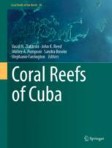Search
Search Results
-
New Quaternary mammals support regional endemism in western Hispaniola
Analysis of largely unstudied fossil collections recovered from caves and sinkholes from western Hispaniola has resulted in the recognition of a new...

-
An integrative study of species distribution modelling and conservation genetics: Magnolia in Hispaniola
On the island of Hispaniola, five endemic species of Magnolia occur, all of which are threatened with extinction. Little is known about their...

-
New insights on black flies (Diptera: Simuliidae) from a touristic destination of Hispaniola
Black flies (Diptera: Simuliidae) are well known as annoying biting pests and vectors of disease-causing agents to humans and other animals. Despite...

-
Deep time extinction of largest insular ant predators and the first fossil Neoponera (Formicidae: Ponerinae) from Miocene age Dominican amber
BackgroundPonerine ants are almost exclusively predatory and comprise many of the largest known ant species. Within this clade, the genus Neoponera ...

-
Besuch auf der Karibik-Insel Hispaniola
Die Karibikinsel Hispaniola ist eine Zwei-Staaten-Insel. Haiti besitzt das westliche Drittel, der größere Ostteil gehört zur Dominikanischen...
-
Rhodocybe-Clitopilus clade (Entolomataceae, Basidiomycota) in the Dominican Republic: new taxa and first reports of Clitocella, Clitopilus, and Rhodocybe for Hispaniola
Based on morphological and phylogenetic investigations, four new species, Clitocella termitophila , Clitopilus velutinus , Rhodocybe dominicana , and Rhod...

-
The Caribbean intertidal mite Alismobates inexpectatus (Acari, Oribatida), an unexpected case of cryptic diversity?
Molecular genetic analyses of Caribbean populations of the supposedly widespread intertidal oribatid mite Alismobates inexpectatus revealed the...

-
Street-level green spaces support a key urban population of the threatened Hispaniolan parakeet Psittacara chloropterus
While urbanisation remains a major threat to biodiversity, urban areas can sometimes play an important role in protecting threatened species,...

-
Genetic structure of Rhinoceros Rock Iguanas, Cyclura cornuta, in the Dominican Republic, with insights into the impact of captive facilities and the taxonomic status of Cyclura on Mona Island
Hispaniola is the second largest island in the Caribbean and harbors an extensive amount of biodiversity. The geologic history and resulting complex...

-
Caribbean Women’s Health and Transnational Ethnobotany
Caribbean Women’s Health and Transnational Ethnobotany. Immigrants from the Dominican Republic (DR) and Haiti are among the top foreign–born...

-
Rapid size change associated with intra-island evolutionary radiation in extinct Caribbean “island-shrews”
BackgroundThe Caribbean offers a unique opportunity to study evolutionary dynamics in insular mammals. However, the recent extinction of most...

-
Community extinction: the groundwater (stygo-)fauna of Curaçao, Netherlands Antilles
The research aimed to recollect specimens from Curaçao of the genus Halosbaena belonging to the rare crustacean order Thermosbaenacea, a genus with a...

-
Outline of the Geology, Geomorphology, and Evolution of the Late Quaternary Shelf and Uplifted Marine Terraces of Cuba: Tectonic and Sea-Level Control of Present-Day Coral Reef Distribution
Cuba, similar to other islands in the Greater Antilles (Hispaniola, Puerto Rico, Jamaica), has an extensive and morphologically complex coastal,...
-
Supella dominicana, a new species of cockroach (Blattida: Ectobiidae) with developed spermatids in Dominican amber
A small, male cockroach (7 mm in length) in Dominican amber is described as Supella dominicana sp. n. (Blattida: Ectobiidae = Blattellidae). The dark...

-
Phylogeny and taxonomy of the Antillean endemic genus Leptocereus (Cactaceae) inferred from chloroplast markers and morphological evidence
Leptocereus is an Antillean genus of thin-stemmed cacti with 17 described species. We carried out a phylogenetic reconstruction with plastid DNA...

-
Linnaeosicyos CUCURBITACEAE
A diagnostic description of the genus is given with special emphasis on the occurrence of succulence amongst its species. The geographical...
-
Patterns of Diversification of Miconia (Miconieae) in the Greater and Lesser Antilles
Miconieae are the largest tribe in the family Melastomataceae with ca. 1900 described species. The Greater and Lesser Antilles harbor an impressive...
-
Geometric Morphometry of the Breast-Shoulder Apparatus of Greater Antillean Anolis Lizards: In Situ Investigation of a Composite Skeletal Assemblage and Its Relationship to Ecomorphological Categorization
The breast-shoulder apparatus (BSA) poses a particular challenge for morphological comparisons, since its skeletal components display a great degree...

